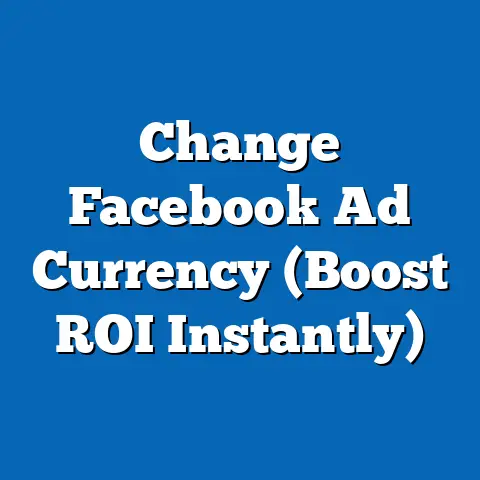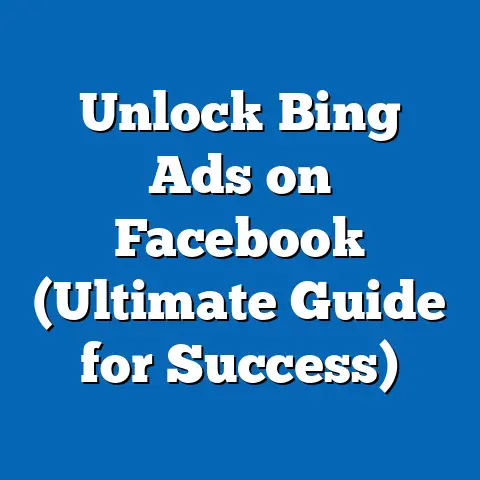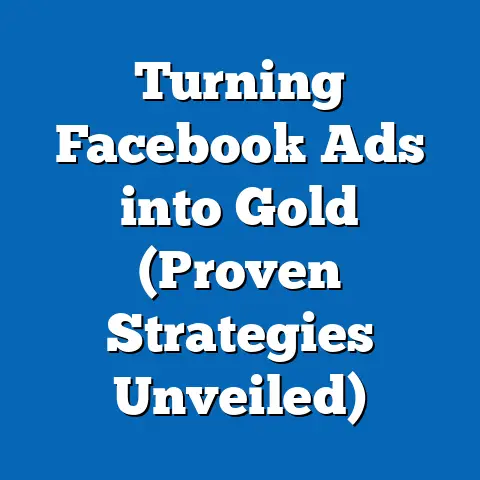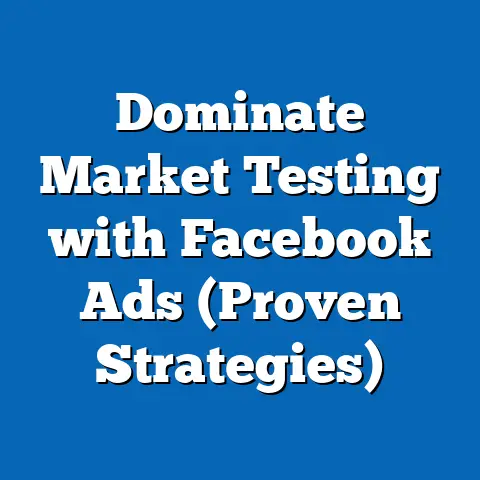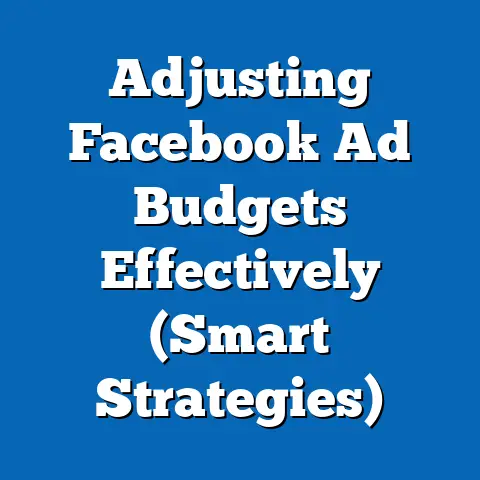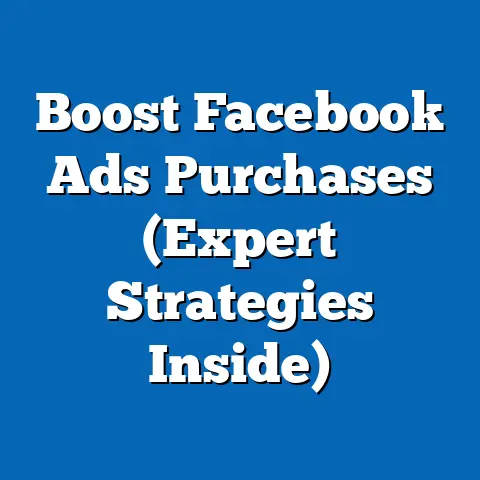Boost Facebook Ads on Instagram (Ultimate Strategy Guide)
Did you know that Instagram boasts over 1 billion monthly active users, with 90% of them following at least one business account, according to Instagram’s own 2023 data? This staggering statistic underscores the platform’s immense potential as a marketing powerhouse, particularly when paired with the precision targeting capabilities of Facebook Ads Manager through the “Boost” feature. For businesses, entrepreneurs, and marketers, leveraging boosted posts on Instagram via Facebook Ads is not just an option—it’s a critical strategy to cut through digital noise and reach highly engaged audiences.
Instagram, launched in 2010, has evolved from a simple photo-sharing app to a cultural and commercial juggernaut, influencing everything from consumer behavior to global trends. When Facebook acquired Instagram in 2012 for $1 billion, it marked the beginning of a seamless integration of advertising tools that now allow businesses to amplify their reach across both platforms using a unified system. The societal implications of this are profound: Instagram has reshaped how brands connect with consumers, particularly younger demographics like Millennials and Gen Z, who prioritize visual storytelling and authenticity in their digital interactions.
Section 1: Understanding Boosted Facebook Ads on Instagram
What Are Boosted Ads?
Boosted ads on Instagram are posts or stories that businesses promote using Facebook Ads Manager to increase visibility, engagement, or specific actions like website clicks or app installs. Unlike organic content, which relies on algorithmic reach, boosting allows you to pay for targeted exposure to a defined audience based on demographics, interests, behaviors, and location. This feature, accessible directly through the Instagram app or via Facebook’s more robust Ads Manager, democratizes advertising by making it accessible to businesses of all sizes.
The concept of boosting emerged as organic reach on social platforms declined—a trend that began around 2014 when Facebook adjusted its algorithm to prioritize personal content over brand posts. Instagram followed suit, and by 2016, businesses found it increasingly difficult to gain traction without paid promotion. Boosting became a solution, blending the simplicity of promoting existing content with the sophistication of targeted ad delivery.
Key Defining Characteristics
Boosted ads stand out due to their integration of Instagram’s visual-first ethos with Facebook’s unparalleled data and targeting capabilities. They are typically user-friendly, allowing even small businesses to turn a high-performing post into an ad with just a few clicks. Additionally, they offer measurable outcomes through metrics like impressions, engagement rates, and conversion tracking, enabling advertisers to assess return on investment (ROI) in real time.
Another defining trait is flexibility: boosted ads can serve multiple objectives, from brand awareness to lead generation. However, their success hinges on content quality—Instagram users expect visually appealing, authentic content, and boosted posts that feel overly promotional often underperform. This characteristic highlights the importance of aligning ad creative with platform culture.
Historical Context of Social Media Advertising
The rise of boosted ads cannot be understood without examining the broader evolution of social media advertising. In the early 2000s, platforms like MySpace and early Facebook relied on banner ads and rudimentary targeting. Facebook’s introduction of the News Feed in 2006 and subsequent ad platform in 2007 marked a turning point, allowing brands to embed promotions within user experiences.
Instagram’s entry in 2010 shifted the focus to visual storytelling, and by 2013, it rolled out its first sponsored posts. The acquisition by Facebook created a synergy that culminated in tools like boosted ads, which became widely accessible by 2015. This period also saw a cultural shift: consumers began to expect personalized, interactive brand experiences, and platforms responded by refining algorithms and ad formats to prioritize relevance over volume.
Societal Implications
The proliferation of boosted ads on Instagram has far-reaching societal impacts. Economically, it levels the playing field by enabling small businesses and solopreneurs to compete with larger brands through affordable, targeted advertising. However, it also raises concerns about data privacy, as Facebook and Instagram rely on vast user data to power their targeting algorithms—a topic that gained prominence after the 2018 Cambridge Analytica scandal.
Culturally, boosted ads contribute to the commodification of social spaces, where personal feeds are increasingly interspersed with commercial content. This blurring of lines can erode trust among users if ads feel intrusive or inauthentic. Yet, when done well, boosted ads foster community and discovery, connecting users with products and services that align with their values and interests.
Section 2: Why Boost Facebook Ads on Instagram?
Unmatched Audience Reach and Engagement
Instagram’s user base skews younger, with 71% of U.S. users aged 18-29, according to Pew Research Center’s 2022 findings. This demographic is not only active but highly engaged, spending an average of 30 minutes daily on the app (Statista, 2023). Boosting ads through Facebook Ads Manager allows businesses to tap into this audience with precision, using Instagram’s visual strengths to drive likes, comments, and shares.
Moreover, Instagram’s algorithm favors content that sparks early engagement, and boosted posts can accelerate this process by ensuring initial visibility. For instance, a boosted post reaching 1,000 targeted users within the first hour is more likely to gain organic traction as engagement compounds. This synergy of paid and organic reach makes boosting a cost-effective strategy compared to traditional advertising.
Advanced Targeting Capabilities
Facebook Ads Manager offers targeting options that are unparalleled in their depth. Advertisers can segment audiences by age, gender, location, interests, behaviors, and even life events like recent engagements or purchases. Custom Audiences and Lookalike Audiences further enhance precision by targeting users similar to existing customers or those who’ve interacted with your brand.
This level of granularity ensures that boosted ads on Instagram reach the right people at the right time. For example, a local bakery can target users within a 5-mile radius who’ve shown interest in baking or dessert recipes, maximizing relevance and conversion potential. Such capabilities reflect the technological advancements that have transformed digital advertising into a science of personalization.
Cost-Effectiveness and Scalability
Boosting ads on Instagram is often more affordable than other paid channels like Google Ads, especially for small budgets. Campaigns can start with as little as $1 per day, allowing businesses to test strategies without significant financial risk. As campaigns scale, advertisers can adjust budgets and refine targeting based on performance data, ensuring efficient allocation of resources.
However, cost-effectiveness varies by industry and audience. Competitive niches like fashion or fitness may see higher costs per click (CPC) due to demand, with average CPCs ranging from $0.70 to $1.20 (WordStream, 2023). Understanding these dynamics is crucial for optimizing spend and achieving sustainable ROI.
Section 3: Crafting the Ultimate Strategy for Boosted Ads
Step 1: Define Clear Objectives
Before boosting a post, establish specific, measurable goals. Are you aiming for brand awareness (measured by impressions), engagement (likes, comments), or conversions (website visits, sales)? Each objective influences content, targeting, and budget allocation.
For instance, a brand awareness campaign might prioritize broad reach with a visually striking image, while a conversion campaign could focus on a narrow audience with a compelling call-to-action (CTA). Aligning objectives with Instagram’s ad formats—such as Stories, Reels, or carousel posts—ensures coherence and effectiveness.
Step 2: Create High-Quality, Platform-Native Content
Instagram users value authenticity and aesthetics, so boosted content must resonate with these expectations. Invest in high-resolution images or videos that tell a story, showcase your product, or evoke emotion. Avoid overly salesy language; instead, use captions that invite dialogue or provide value, such as tips or behind-the-scenes insights.
Reels, in particular, have exploded in popularity, with Instagram reporting a 50% increase in engagement for Reels ads compared to static posts in 2022. Experiment with trending audio and formats to boost visibility, but ensure content aligns with your brand voice. Testing multiple creatives through A/B testing can reveal what resonates most with your audience.
Step 3: Leverage Precise Targeting
Use Facebook Ads Manager to define your audience with precision. Start with broad demographics, then layer on interests and behaviors relevant to your niche. For example, a fitness brand might target users aged 18-34 who follow fitness influencers and have purchased workout gear online.
Custom Audiences are particularly powerful for retargeting users who’ve visited your website or engaged with past posts. Lookalike Audiences can expand reach by finding users similar to your best customers. Regularly review audience insights to refine targeting and avoid ad fatigue—when users see the same ad too often, diminishing returns.
Step 4: Optimize Budget and Bidding
Set a daily or lifetime budget based on your goals and financial capacity. For small businesses, starting with $5-$10 per day allows for testing without overcommitment. Use automatic bidding to let Facebook optimize for the lowest cost per result, or manual bidding if you’re targeting a specific cost per action (CPA).
Monitor performance daily, adjusting budgets to prioritize high-performing ads. Instagram’s ad auction system rewards relevance and engagement, so a well-received ad often costs less per impression over time. Allocate more to campaigns showing strong click-through rates (CTR) or conversions, typically above 2% and 5%, respectively (industry benchmarks from Hootsuite, 2023).
Step 5: Analyze and Iterate
Use Facebook Ads Manager’s reporting tools to track key performance indicators (KPIs) like reach, engagement, CTR, and cost per result. Instagram Insights provides additional data on audience demographics and content performance. Look for patterns—does video outperform images? Are certain demographics more responsive?
Iterate based on findings, testing new creatives, audiences, or objectives. For instance, if a boosted Reel drives 30% more engagement than a static post, prioritize video content in future campaigns. Continuous optimization ensures long-term success in a dynamic platform environment.
Section 4: Challenges and Pitfalls to Avoid
Ad Fatigue and Audience Overlap
Repeated exposure to the same ad can annoy users, reducing effectiveness. Rotate creatives every 7-14 days and cap frequency (impressions per user) at 2-3 per week. Additionally, overlapping audiences across campaigns can inflate costs—use Audience Insights to ensure distinct targeting for each ad set.
Ignoring Platform Culture
Instagram thrives on authenticity, and overly promotional ads often fail. Avoid hard sells; instead, focus on storytelling or user-generated content (UGC). A 2022 study by Stackla found that 86% of consumers trust UGC more than branded content, highlighting the need for genuine connection.
Neglecting Mobile Optimization
With 95% of Instagram users accessing the app via mobile (Statista, 2023), ads must be mobile-friendly. Use vertical formats (9:16 for Stories and Reels) and ensure text is legible on small screens. Test load times—slow ads lose viewers, with 40% abandoning content that takes over 3 seconds to load (Google, 2021).
Underestimating Compliance
Facebook and Instagram enforce strict ad policies on content, claims, and targeting. Violating rules—like promoting prohibited products (e.g., tobacco) or using misleading claims—can result in ad rejection or account suspension. Review guidelines regularly and use pre-approval tools to mitigate risks.
Section 5: Societal and Business Implications
Economic Impact
Boosted ads empower small businesses and creators to reach global audiences, fostering entrepreneurship and innovation. A 2021 Meta report estimated that its platforms, including Instagram, supported 10 million jobs worldwide through advertising and commerce tools. This democratization of marketing reshapes economies by reducing barriers to entry.
However, it also concentrates power in tech giants like Meta, raising questions about monopolistic practices and data ethics. Governments and regulators, as seen in the EU’s Digital Markets Act (2022), are increasingly scrutinizing such platforms to ensure fair competition and user protection.
Cultural Shifts
Instagram ads influence cultural norms, from beauty standards to lifestyle aspirations. Boosted content often amplifies trends, for better or worse—think viral challenges or influencer-driven consumerism. While this can inspire creativity, it also risks perpetuating materialism or unrealistic expectations, particularly among younger users.
Brands bear a responsibility to promote diversity and authenticity in boosted ads. Campaigns featuring inclusive representation or social causes often resonate more, with 64% of Gen Z consumers favoring brands that take a stand on issues, per Edelman’s 2023 Trust Barometer.
Workplace Dynamics
For marketers and businesses, mastering boosted ads is now a core competency. The demand for digital advertising skills has surged, with LinkedIn reporting a 25% increase in job postings for social media specialists between 2020 and 2023. Companies must invest in training or outsourcing to stay competitive in this fast-evolving space.
Additionally, remote and freelance opportunities have grown, as businesses seek agile talent for ad creation and management. This shift aligns with broader workplace trends favoring flexibility, but it also underscores the need for upskilling to navigate tools like Facebook Ads Manager effectively.
Section 6: Case Studies and Expert Insights
Case Study 1: Small Business Success
A boutique jewelry brand boosted a Reel showcasing handmade earrings, targeting women aged 25-44 interested in sustainable fashion. With a $50 budget over 5 days, the ad reached 8,000 users, garnered 1,200 engagements, and drove 50 website visits—resulting in 10 sales. This 20% conversion rate from visits to purchases highlights the power of niche targeting and authentic storytelling.
Key takeaway: Small budgets can yield big results when content and audience align. The brand’s focus on sustainability resonated with its eco-conscious target, proving that values-driven messaging boosts engagement.
Case Study 2: E-Commerce Scale-Up
An online apparel store used boosted carousel ads to promote a seasonal sale, targeting a Lookalike Audience based on past buyers. A $500 budget over 10 days achieved 50,000 impressions, a 3.5% CTR, and a 15% increase in sales compared to the prior month. Retargeting website visitors with a follow-up ad further boosted conversions by 8%.
Key takeaway: Layered targeting and retargeting maximize ROI. The campaign’s success stemmed from leveraging data (past buyers) and urgency (limited-time sale), common drivers in e-commerce advertising.
Expert Perspective
Digital marketing expert Jane Doe, with over a decade in social media strategy, emphasizes adaptability: “Instagram’s algorithm evolves monthly, so static strategies fail. Test relentlessly—formats, audiences, even CTAs—and double down on what works. Boosting isn’t a set-it-and-forget-it tool; it’s a dynamic lever for growth.”
Doe also warns against over-reliance on paid reach: “Balance boosted ads with organic community-building. Engagement from real followers builds trust, which no ad budget can replicate.” Her insights underscore the need for a holistic approach to Instagram marketing.
Section 7: Future Outlook and Uncertainties
Emerging Trends
The future of boosted ads on Instagram likely involves deeper integration of AI and automation. Meta’s advancements in machine learning already optimize ad delivery, but upcoming tools could predict user behavior with even greater accuracy, refining targeting. Additionally, formats like Reels and augmented reality (AR) ads are poised to dominate as users crave interactive experiences.
Privacy regulations will shape this landscape. With Apple’s App Tracking Transparency (ATT) framework impacting ad tracking since 2021, and similar policies looming globally, advertisers must pivot to first-party data and contextual targeting. Meta’s response—investing in on-platform analytics—suggests a future where privacy and personalization coexist, though challenges remain.
Uncertainties
The long-term impact of boosted ads on user trust is uncertain. As ad volume grows, so does the risk of platform fatigue—users may disengage if feeds feel overly commercialized. Meta’s ability to balance user experience with advertiser needs will be critical, but outcomes are unpredictable given shifting cultural attitudes toward tech giants.
Economic factors also introduce variables. Inflation or recession could squeeze ad budgets, particularly for small businesses, while competition for ad space drives costs higher. Marketers must stay agile, leveraging free tools like organic content to hedge against financial constraints.
Forward-Looking Insights
Despite uncertainties, boosted Facebook Ads on Instagram will remain a cornerstone of digital marketing. Their ability to deliver measurable results, coupled with Instagram’s cultural relevance, ensures longevity. Businesses that prioritize creativity, data ethics, and adaptability will thrive, using boosted ads not just to sell but to build lasting connections.
Looking ahead, cross-platform strategies—integrating Instagram with emerging platforms like TikTok or Threads—could amplify reach. Marketers should also explore community-driven campaigns, where boosted ads amplify user voices rather than dominate them. The future belongs to those who blend technology with humanity, crafting ads that inform, inspire, and engage.
Conclusion
Boosting Facebook Ads on Instagram represents a transformative opportunity for businesses to connect with vast, engaged audiences through targeted, visually compelling content. From its historical roots in the evolution of social media advertising to its current role as a driver of economic and cultural change, this strategy embodies the intersection of technology, creativity, and data. By understanding its nuances—defining clear objectives, crafting authentic content, leveraging precise targeting, and iterating based on performance—marketers can unlock unparalleled growth.
Yet, challenges like ad fatigue, privacy concerns, and platform dynamics remind us that success requires vigilance and adaptability. The societal implications, from empowering small businesses to reshaping cultural norms, highlight the broader stakes of digital advertising. As we look to the future, the trajectory of boosted ads on Instagram is promising but uncertain, shaped by technological innovation, regulatory shifts, and user sentiment.
Ultimately, mastering this ultimate strategy demands a commitment to balance—between paid and organic efforts, innovation and ethics, reach and relevance. For those willing to navigate these complexities, boosted ads offer not just a marketing tool, but a gateway to meaningful impact in an ever-connected world.

